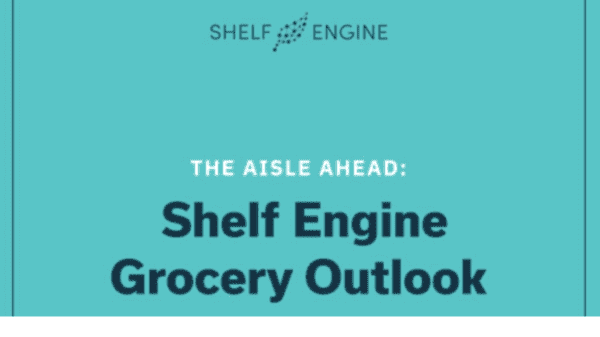Grocers will increasingly adopt strategies including technology and mergers to attract and keep customers and gain the upper hand over challenges that lie in wait for 2023, according to grocery artificial intelligence leader Shelf Engine.
With inflation persisting at 7.7 percent according to the U.S. Bureau of Labor Statistics, grocers will look to generate higher margins and avoid passing rising costs onto consumers. The Labor Department reports employers are hard-pressed to fill 10.7 million openings.
Grocers will seek innovative solutions to plug that gap. Despite the labor shortage, retailers will strive to cement shifting consumer loyalties by differentiating the shopping experience amidst intense competition.
In The Aisle Ahead: Shelf Engine Grocery Outlook, company leaders foresee these 10 trends disrupting the industry next year:
How grocers will combat surging prices
Trend: Absorbing inflation
Grocers will find creative ways to battle inflation on behalf of customers. Knowing the impact of rising prices on consumers, retailers will absorb margin hits, rely on technology more in store and omnichannel, and reduce costs. They’ll make tough choices to allocate resources, using customer satisfaction and loyalty as their guide. – Ben Schmidlin, senior director
Trend: Pricier deliveries
Shoppers will pay more for grocery delivery, with free service becoming a thing of the past in this $140 billion category. Companies will no longer be able to subsidize this as a free or low-cost service. Fees will increase or roll into an exclusive service, such as Walmart+. This will spill over into more in-person shopping and curbside pick-up as inflation-weary consumers cut costs. – Sophi Kim, head of product management
Shifting shopper behaviors and preferences
Trend: Fragmented shopping
Food prices are up 10.9 percent from a year ago. Consumers stretching their dollars are chasing value with a wider store repertoire. This fragmented shopping means some are using club stores while others are trying dollar stores or hard discount offers for the first time. When inflation initially hit, customers stayed with the familiar. But in this phase of recession retailing, they’ll try new ways to make the most of budgets. – John Burry, strategic advisor
Trend: Consumer connections
Brands will escalate efforts to connect consumers to their mission and values. If they can show their brand satisfies crucial needs, shoppers will pay a premium, even when watching spending closely. Almost 90 percent will pay more for a brand they trust. To build this bond, more brands will promote social responsibility, including upcycling and waste reduction. – Michael Schall, advisory board member
Ways grocery retailers will compete smarter
Trend: Capitalizing on differentiators
Grocers with differentiated offers will excel based on customer preferences in this hyper-competitive climate. Discounters with minimal service will do well attracting bargain-hunters. At the other end, retailers with distinctive offerings will also prosper. For example, as shoppers search for affordable convenience, expect a new generation of food court/foodservice offers in large format and convenience stores. – John Burry
Trend: Growing gulf
The divide between small chains and independent retailers on one hand and big chains on the other will widen. To differentiate themselves from big players, small grocers will lean in heavily to fresh and local products and a great customer experience. But rising prices and competing priorities may make this strategy difficult. – Ben Schmidlin
Trend: Increased consolidation
Consolidation of retailers of all sizes will accelerate, with the $24.6 billion Kroger-Albertsons merger just one example. More companies will struggle to attract customers and keep costs at bay. Companies will achieve efficiencies through scale, which gives them more power in areas such as price negotiations with suppliers. – Sophi Kim
How technology will provide an edge
Trend: Tech acceleration
Food technology is a $220 billion industry and continues to grow. Grocers will turn to tech to solve issues, such as the labor shortage and rising costs. Technology can replace humans for repetitive tasks so its use will accelerate. A format such as Amazon Go eliminates cashiers. Robots can save hours of labor. Artificial intelligence can do everything from forecasting demand to automating ordering. – Michael Schall
Trend: Centralized ordering
Centralized ordering will grow as chains achieve more efficiencies from a single purchasing source. Headquarters sets company-wide goals to maximize sales or margins and control financial performance with a lower range of error. If individual stores control ordering, even a small change could result in lost sales or food waste. Their manual SKU adjustments may not look big but add up. – Stefan Kalb, co-founder and CEO
Trend: Order automation
Computer assisted ordering will start falling by the wayside. CAO tools drain scarce staff time, introduce bias and error, and aren’t strong at forecasting demand and on-hand inventory. Instead, automated replenishment systems will take hold. Their forecasting and ordering is more accurate than the store’s. Order automation creates a competitive edge by saving labor and delivering greater profit and a better shopper experience. – Stefan Kalb
About Shelf Engine
Shelf Engine helps grocers maximize results by using artificial intelligence to predict shopper demand with world-class accuracy, provide a precise view of on-hand inventory and automate the ideal order every day, in every store. Launched in 2016, Seattle-based Shelf Engine assists leading retailers at thousands of locations nationwide to grow profits, increase sales, reduce waste and decrease labor costs. For more information, visit www.shelfengine.com.



